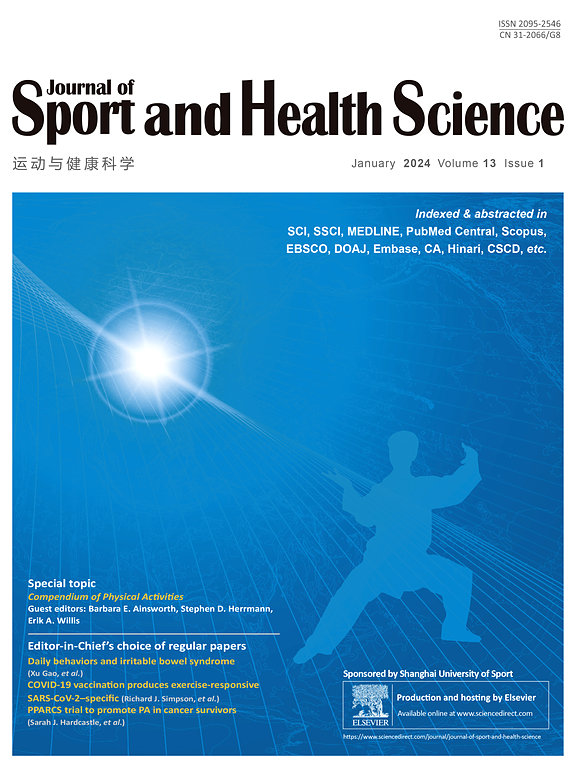Exercise-induced extracellular vesicles delay tumor development by igniting inflammation in an immunologically cold triple-negative breast cancer mouse model.
IF 10.3
1区 医学
Q1 HOSPITALITY, LEISURE, SPORT & TOURISM
引用次数: 0
Abstract
BACKGROUND Preclinical studies demonstrate that exercise reduces tumor incidence and growth. Rapid release of extracellular vesicles (EVs) during exercise suggests their potential role as mediators of exercise-induced systemic effects and physiological adaptation. This study investigated the impact of exercise-induced plasma EVs on tumor growth and immune tumor microenvironment in murine models of triple-negative breast cancer (TNBC): EO771 (a C57BL/6-derived TNBC cell line) and 4T1 (a BALB/c-derived TNBC cell line). METHODS Size exclusion chromatography was used to isolate exercise-induced EVs from plasma of healthy female mice (BALB/c and C56BL/6, n = 30 per strain) that underwent ten 30-min moderate-intensity treadmill running sessions over 2 weeks. Nanoparticle tracking analysis, Western blot, and electron microscopy confirmed the presence of EVs in the samples. Tumor-bearing mice (n = 72 per strain) were administered with exercise-induced EVs before or/and after tumor implantation. Local and systemic immune responses were assessed using flow cytometry, enzyme-linked immunosorbent assay (ELISA), and quantitative polymerase chain reaction (qPCR). RESULTS Administration of exercise-induced EVs, particularly before tumor implantation, significantly suppressed tumor growth and reduced tumor burden in both TNBC models. In EO771, endpoint tumor volumes were 278-330 mm³ in treated groups compared to 799 mm³ in untreated (p < 0.0001), while in 4T1, treated groups showed volumes of 287-564 mm³ vs. 696 mm³ in untreated (p = 0.0002). Notable differences in tumor-infiltrating lymphoid and myeloid cell subpopulations indicated immunomodulatory effects of exercise-induced EVs, particularly in the 4T1 model, where their continuous administration significantly increased intratumoral cluster of differentiation 8 (CD8) T lymphocyte proportion (5.77% vs. 0.90% in untreated, p < 0.0001). Similarly, in the EO771 model, exercise-induced EVs administered before tumor implantation led to a marked rise in intratumoral CD8 T lymphocytes (2.24% vs. 1.08% in untreated, p = 0.0181). CONCLUSION Our findings indicate that exercise-induced EV treatment elicits a pro-inflammatory antitumor immune response, suggesting a shift of immunologically cold TNBC tumors towards a more inflamed phenotype associated with better outcomes. Our study supports the further investigation of EVs as modulators of antitumor immunity and their potential utility in enhancing the efficacy of immunotherapy.在免疫冷三阴性乳腺癌小鼠模型中,运动诱导的细胞外囊泡通过点燃炎症延迟肿瘤的发展。
背景临床研究表明,运动可降低肿瘤的发病率和生长。运动过程中细胞外囊泡(EVs)的快速释放表明,它们可能是运动诱导的全身效应和生理适应的介质。本研究在三阴性乳腺癌(TNBC)小鼠模型中研究了运动诱导的血浆 EVs 对肿瘤生长和免疫肿瘤微环境的影响:方法使用尺寸排阻色谱法从健康雌性小鼠(BALB/c和C56BL/6,每个品系n = 30)的血浆中分离运动诱导的EVs,这些小鼠在2周内进行了10次30分钟中等强度的跑步机跑步。纳米粒子追踪分析、Western印迹和电子显微镜证实了样品中存在EVs。肿瘤小鼠(每品系 72 只)在肿瘤植入前或植入后接受运动诱导的 EVs 治疗。使用流式细胞术、酶联免疫吸附试验(ELISA)和定量聚合酶链反应(qPCR)评估了局部和全身免疫反应。结果在两种 TNBC 模型中,运动诱导的 EVs 给药,尤其是在肿瘤植入前给药,能显著抑制肿瘤生长并减少肿瘤负荷。在 EO771 中,治疗组的终点肿瘤体积为 278-330 立方毫米,而未治疗组为 799 立方毫米(p < 0.0001);在 4T1 中,治疗组的肿瘤体积为 287-564 立方毫米,而未治疗组为 696 立方毫米(p = 0.0002)。肿瘤浸润淋巴细胞和髓系细胞亚群的显著差异表明运动诱导的 EVs 具有免疫调节作用,特别是在 4T1 模型中,连续给药可显著增加瘤内分化 8(CD8)T 淋巴细胞群的比例(5.77% 对未处理的 0.90%,p < 0.0001)。同样,在 EO771 模型中,肿瘤植入前给药的运动诱导 EV 导致瘤内 CD8 T 淋巴细胞明显增加(2.24% 对未处理的 1.08%,p = 0.0181)。我们的研究支持进一步研究作为抗肿瘤免疫调节剂的 EVs 及其在提高免疫疗法疗效方面的潜在作用。
本文章由计算机程序翻译,如有差异,请以英文原文为准。
求助全文
约1分钟内获得全文
求助全文
来源期刊

Journal of Sport and Health Science
SPORT SCIENCES-
CiteScore
18.30
自引率
1.70%
发文量
101
审稿时长
22 weeks
期刊介绍:
The Journal of Sport and Health Science (JSHS) is an international, multidisciplinary journal that aims to advance the fields of sport, exercise, physical activity, and health sciences. Published by Elsevier B.V. on behalf of Shanghai University of Sport, JSHS is dedicated to promoting original and impactful research, as well as topical reviews, editorials, opinions, and commentary papers.
With a focus on physical and mental health, injury and disease prevention, traditional Chinese exercise, and human performance, JSHS offers a platform for scholars and researchers to share their findings and contribute to the advancement of these fields. Our journal is peer-reviewed, ensuring that all published works meet the highest academic standards.
Supported by a carefully selected international editorial board, JSHS upholds impeccable integrity and provides an efficient publication platform. We invite submissions from scholars and researchers worldwide, and we are committed to disseminating insightful and influential research in the field of sport and health science.
 求助内容:
求助内容: 应助结果提醒方式:
应助结果提醒方式:


